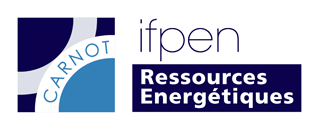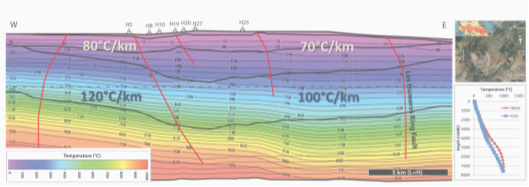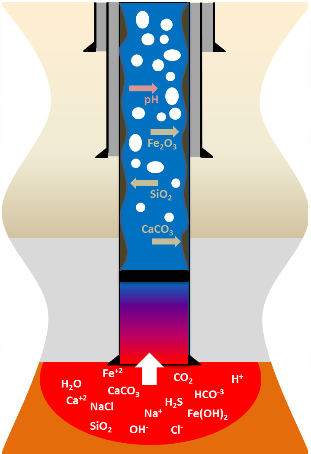 Geothermal energy
Geothermal energy
Our solutions
IFPEN proposes a global approach to geothermal energy, from the evaluation of resources through to the dimensioning of surface facilities, production and reinjection well modeling and deposit risks. The approach combines laboratory experiments, advanced modeling and technical and economic assessments.
To achieve its objectives and address the problems encountered by geothermal energy operators, IFPEN draws on the multidisciplinary expertise it initially developed for oil and gas exploration and production, particularly relating to underground modeling software (on a basin and reservoir scale).
EVALUATION OF GEOTHERMAL RESOURCES
There are two broad categories of geothermal resources: firstly, low and ultra-low energy sources in the form of sedimentary basin aquifers and, secondly, medium- and high-energy sources located in fractured reservoirs and magma zones.
The geothermal energy in French sedimentary basins will help the country achieve the objectives set out in its long-term energy plan (PPE). It will be necessary to continue to exploit the Dogger aquifer in the Paris basin, but also to target other reservoirs within the basin and elsewhere in France.
Sedimentary basins are associated with a number of challenges:
• Their exploration and assessment of their potential (temperature, permeability, pressure, etc.) and risks (CO2, H2S, hydrocarbons),
• Assessment of reservoirs, taking into consideration heterogeneities and their impact on flows,
• The understanding of reservoir behavior during production operations, the evolution of thermicity and water-rock interactions,
• The maintenance of siliciclastic reservoir injectivity, taking into account reservoir mineralogy and water microbiology and stability.
Magma zones and fractured reservoirs require complementary assessments. Assessment of the existing thermal structure is only possible if it is supported by a precise understanding of:
• The genesis - and hence existing distribution - of natural fracturing
• The evolution of the fracture network with production,
• The impact of connectivities on the recovery of heat and associated products, such as lithium, throughout the exploitation period.
IFPEN is studying the exploitation of reservoirs in the deep magma environment within the framework of collaborative European projects such as GECO and DEEPEN. GECO draws on experience relating to the re-injection of non-condensable gases acquired in the H2020 project CarbFix in Iceland to set up a zero-emissions geothermal operation in Italy.
IFPEN has access to powerful modeling tools to assess the potential of geothermal resources: TemisFlow™, CooresFlow™ and PumaFlow™.
TemisFlow™ basin modeling software, initially developed for oil and gas exploration, can be used to model:
- Sedimentary heterogeneity resulting from the tectono-stratigraphic evolution of the basin,
- Deposits, compaction and flows throughout the basin’s history, in order to:
- Evaluate temperatures, heat flows, pressures, porosities and associated permeabilities,
- Gain an understanding of fluid flow and geochemical behavior, particularly the evolution of salinity and CO2 and H2S generation, but also lithium leaching and transport in deep water environments.
Using this information, it is possible to:
• Evaluate heat flows and geothermal potential, as well as risks related to the fluid chemistry and associated additional costs,
• Anticipate the constraints associated with re-injection.
The CooresFlow™ underground storage behavior modeling software solution incorporates functionalities such as:
• Porous media drying modeling,
• Counter-current water displacement by capillary re-imbibition,
• Salt transport
• The evolution of porosity and permeability.
These functionalities, validated and exploited in a geothermal context, make it possible to accurately take into account the needs of geothermal energy operators.
PumaFlow™ reservoir simulation software can also be used to predict fluid evolution in a geothermal reservoir.

A WELL MODEL: DEPOSIT AND CORROSION ASSESSMENT
Wells present specific problems, such as the risks of mineral deposits (limestone, etc.) and corrosion, that require knowledge of the evolution of temperature, phases and their thermodynamic properties, as a function of production history.
To this end, IFPEN developed the GWellFM well model to simulate the monophase and two-phase flows of a multi-component mixture, taking into account:
• Vertical flow hydrodynamics for various regimes (monophase: gas and liquid, or two-phase: dispersed, intermittent and annular),
• Thermodynamics, mixture behavior laws, phase equilibrium calculations,
• Thermal exchange with the surrounding rocks.
GWellFM well simulation software solves mass balances, movement and enthalpy in a stationary regime. It can be used for any well configuration (production or injection) and any condition (shallow low-temperature or deep high-temperature geothermal energy). GWellFM also has an option to model thermal transfer between fluid and the surrounding rock in a transient regime, making it possible to conduct simulations with variable flow rates and input conditions, simulate production and injection history, model the shutdown process and study the effect of fluid temperature (production or injection) in the vicinity of the well.
GWellFM is also enhanced with a geochemical model to assess the risk of deposits in the wells.

SURFACE FACILITIES: OPTIMIZATION AND DIMENSIONING
Surface facilities must be designed and optimized to address energy requirements, particularly in terms of seasonal energy flexibility (heat versus electricity) but also in terms of cogeneration (heat and electricity) and coproduction.
Also worthy of note: oil well heat recovery has become a major challenge in terms of limiting the greenhouse gas emissions of oil and gas facilities.
IFPEN, working alongside its subsidiary BeicipFranlab, is conducting modeling and technical and economic assessments in order to:
• Evaluate the energy potential of reservoirs with a production history
• Propose efficient surface solutions incorporating existing processes.
The performance of surface solutions is primarily hinged around the capacity to extract thermal energy from the fluid exiting the well and use it to provide heat or convert it into electricity.
In order to estimate thermal or electrical efficiency, process software is used to simulate and optimize surface facilities, either isolated or integrated within an existing process.
Simulation results are used to establish:
• The dimensioning of surface equipment
• An estimation of costs
• A comparative study of the various configurations possible with a view to identifying the most appropriate solution.
The GWellFM well model, combined with a surface simulation tool, is also used to design well completion and compressors in such a way as to obtain total fluid reinjection.
Take-aways
Using their process simulation expertise and their knowledge of surface equipment, IFPEN and its partner BeicipFranlab design adapted and optimized geothermal energy recovery facilities.
Alongside this range of services, IFPEN has technical resources for the in-depth study of mineral deposits in heat exchangers, which ultimately become less efficient over time. A HEATER FOULING-type experimental facility has been set up for the purpose.






